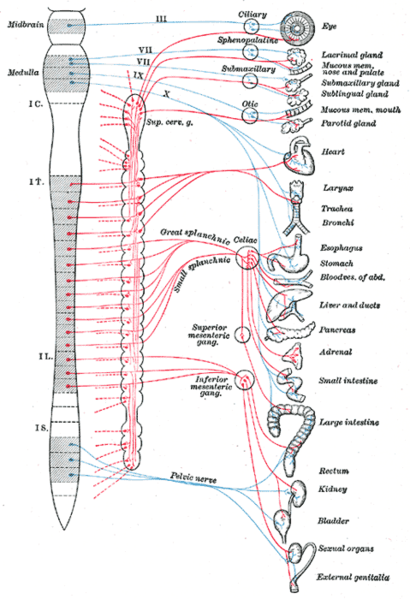Introduction
A sneeze is a semi-autonomous, convulsive expulsion of air from the lungs through the nose and mouth, usually caused by foreign particles irritating the nasal mucosa.
Those trigger the release of histamines, which irritate the nerve cells in the nose, resulting in signals being sent to the brain to initiate the sneeze through the trigeminal nerve network.
The neural region involved in the sneeze reflex is located in the brainstem along the ventromedial part of the spinal trigeminal nucleus and the adjacent pontine-medullary lateral reticular formation.
This region appears to control the epipharyngeal, intrinsic laryngeal and respiratory muscles, and the combined activity of these muscles serves at the basis for the generation of a sneeze.

It may seem outlandish, but sneezing is not only a reflex that has developed to clear the nasal passages of particulate matter and other irritants: studies have been conducted which have been shown that sneezing can be induced by sexual ideation or orgasm.
Sexually induced sneezing occurs independently from external nasal stimuli or allergenes, and may occur at any point during a sexual experience.
It could be known as honeymoon rhinitis.
Epidemiology
Both men and women could be affected by the phenomenon throughout their adult life. Indeed this is more common than recognized because these are unusual and embarassing symptoms of which may not be easy to discuss with physicians, but it is easier to talk about this kind of problem in Internet chat rooms and forums; it' more comfortable to seek advice anonymously.
History
Already in 19th century, Watson in 1875 and John Nolan Mackenzie in 1884 have noted a link between the nose and sexual excitement but there was no credible reason given for the phenomenon.
Besides, on the "Journal of the American Medical Association" of 1972 was described a 69-year-old man with severe sneezing immediately following orgasm, again with no psychiatric morbidity.
At last in 2008, Dr Mahmood Bhutta and Dr Harold Maxwell performed the first full-scale investigation of the case with an article on the "Journal of the Royal Society of Medecine".
The physiological and pathological relations between the nose and the sexual apparatus of a man (The Journal of Laryngology, Rhinology and Otology, 1898)
Sneezing induced by sexual ideation or orgasm: an under-reported phenomenon (Journal of the Royal Society of Medecine, 2008)

Potential Mechanisms
But what happens during reflection? What is the trigger?
There are three possible explanations of the event, the third of which seems to be the most accredited:
1. PSYCHIATRIC MECHANISM the sneeze represents a forceful emission of sexual tension. Indeed this theory is not reliable because sneezing is reflex and not volitional.
2. HUMORAL MECHANISM after establishing the existence of erectile tissue in the nose similar to the genital organs tissue. According to this theory, nitric oxide released to provoke genital tumescence enters the bloodstream and causes engorgement and irritation of the nasal mucosa too. But this would take a long time to be affected and in penile erection probably nitric oxide is released locally but does not enter the systemic circulation to an appreciable extent.
3. PARASYMPATHETIC SUMMATION because of the immediacy of the response, perhaps a neurological mechanism rather than a humoral one causes this phenomenon.
The reason should be sought at the autonomic nervous system level: the neurons that will subsequently form the cranial outflow of the parasympathetic nervous system originate in the vagal region of the embryonic neural tube, in a region not too distant from the putative future sneeze centre. Furthermore, the parasympathetic nervous system is phylogenetically old and is not arranged somatically. There is evidence of persisting links between different components of the parasympathetic nervous system, whereby stimulation of one parasympathetic response will lead to other responses.

When there is a sexual ideation, a parasympathetic outflow causes venous dilation leading to penile or clitoral tumescence. Thus, the efferents from the primary parasympathetic nucleus will also project back to their embryonic origin at the vafal nuclei, which may in turn stimulate other parasympathetic responses.
Maybe the greater superficial petrosal nerves are stimulates, which realy via the pterygopalatine ganglion to effect nasal secretion and consequent irritation.
The parasympathetic nervous system uses chiefly acetylcholine (ACh) as its neurotransmitter, who acts on two types of receptors, the muscarinic and nicotinic cholinergic receptors. Usually when stimulated, the preganglionic nerve releases ACh at the ganglion, which acts on nicotinic receptors of postganglionic neurons. The postganglionic nerve then releases ACh to stimulate the muscarinic receptors of the target organ.
 Acetylcholine
Acetylcholine

This nasal stimulation will then results in a sneezing response, due to a stimulus other than physical irritation.
Genetic Inheritance
We can assume that sneezing in response to sexual ideation or orgasm could be inherited in an autosomal dominant manner: previously it is thought that sneezing like photic sneeze reflex and in response to fullness of the stomach are inherited in an autosomal dominant pattern, and both are probably caused by parasympathetic system-dependents mechanisms.
It may be difficult to know, because in general parents and children are unlikely to discuss about certain topics that put both in awe.
Conclusion
Sexually induced sneezing is a curious phenomenon that needs further clarifications. Until now the most likely cause is the mechanism of parasympathetic summation, but the sneeze reflex needs to be investigate in more depth.